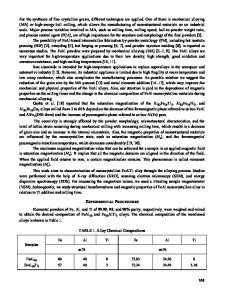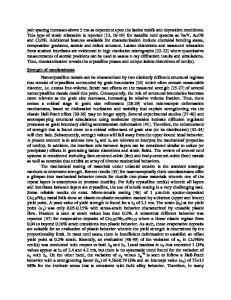The Effects of Ternary Elemental Additions on the Structure and Magnetic Properties of Nanocrystalline Feco Powders
- PDF / 172,981 Bytes
- 6 Pages / 612 x 792 pts (letter) Page_size
- 82 Downloads / 285 Views
BB5.48.1
THE EFFECTS OF TERNARY ELEMENTAL ADDITIONS ON THE STRUCTURE AND MAGNETIC PROPERTIES OF NANOCRYSTALLINE FeCo POWDERS 1
2
3
1
I. Baker , R.G. Quiller , M. Robson , D. Wu Thayer School of Engineering, Dartmouth College, Hanover, NH 03755-8000 2 Department of Mathematics, Rensselaer Polytechnic Institute, 110 8th St., Troy, NY 12180 3 The Cooper Union for the Advancement of Science and Art, Cooper Square, New York, NY 10003-7120 1
ABSTRACT Powders of near-equiatomic Fe and Co were mechanically milled with additions of Zr, C, Ni, Cu and/or B for 60 hr using stainless steel balls in a Svegari attritor operated at 1300 r.p.m. under o argon. The milled powders were examined before and after annealing at 600 C. The morphologies and sizes of the powders were examined using a scanning electron microscope. The grain sizes were characterized from the widths of X-ray diffraction peaks obtained using a computer-controlled x-ray diffractometer and the lattice parameters were determined. The resulting magnetic properties were measured using a vibrating sample magnetometer. INTRODUCTION B2-structured Fe-Co, which exists from ~25-75 at.% Co at room temperature [1], exhibits othe largest magnetic induction of any material (for 25-50 at.% Co), a Curie temperature near 950 C, and, near the stoichiometric composition, a large permeability [2]. Suitably alloyed and processed, it is of interest as rotor material for use at high temperatures in gas turbine engines for electric power generation [3]. Commercial alloys often contain 2 wt.% V (in equiatomic Fe-Co) in order to increase both the ductility and the electrical resistivity. The former enables easier processing, while the latter allows a reduction in eddy current losses. Theoyield strength of FeCo-2V is almost independent of temperature from room temperature to 700 C [4]. However, o a disadvantage with the 2V addition is that a disordered second phase appears between 580 C o o and 730 C, limiting the application temperature of this alloy to temperatures below 580 C [5]. There have been two recent studies of mechanical milling of Fe-Co alloys. He et al. [6] milled commercially-available prealloyed FeCo-2V in methanol using a Union Process attritor at 250 r.p.m. A grain size of 35 nm was obtained after milling for 20 hr, which was maintained for milling times up to 60 hr. In contrast, Kim et al. [7] milled elemental powders of Fe and Co containing from 0-80 at.% Co using a horizontal rotary ball mill at 1300 r.pm. and obtained a roughly steady-state grain size of ~10 nm after 30 hr of continuous milling. Interestingly, they were able to obtain this grain size after only 15 hr using cyclic milling in which the rotation rate was periodically changed from 1300 r.p.m. for 4 minutes to 900 r.p.m. for 1 minute. They obtained the maximum saturation magnetization and minimum coercivity for milled powders containing 30 at.% Co. The coercivity of othe latter alloy decreased rapidly as the grain size o increased during annealing at 400 C or 500 C. At room temperature, stoichiometric
Data Loading...











